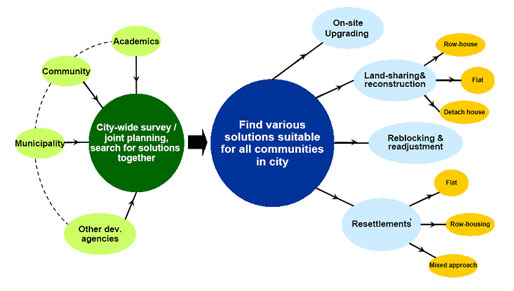The main factors governing Urban planning are: Climate Change,Resource Depletion,Food Insecurity and Economic Instability. If cities have to be sustainable for the future these issues have to be addressed immediately. An argument was put forward in the meetings of UN Habitat world forum and the World planners congress in Vancouver, 2006 that the profession of Urban planning has to be reviewed under the light of policies which are pro-poor and create sustainable livelihoods at the center of planning efforts.
Influential Forms of Urban Planning of the 20th Century
1. Neighborhood Unit - Low population density,full of open spaces, focused on community facilities, and assumed to create viable social communities.
2.Radburn Layout - Separates motorized traffic from pedestrians, characterized by open spaces and super blocks free of traffic.
3. Urban Renewal - Slum clearance and rehousing projects following Radburn and neighborhood layouts.
4. Road Hierarchy - creates a hierarchy of roads to take care of the urban traffic and its management. The lowest level of the hierarchy is the Environmental Cell, which takes care of local traffic. At the higher levels are the district and long distance traffic grids.
5. Suburbia - Assumes very high level of car ownership and large densities of population around structured areas of growth in a city. The residential complexes are development at the Urban periphery, are single family units and consists of large areas of Car movement systems and community facility networks.
The challenges confronting the cities of 21st Century
Environmental Concern -
1.The economics of climate change include access to basic elements of life such as Drinking water,Food production, and health and sanitation requirements.
2. Current economies are Oil based. Hence emission control is a major concern in both developing and developed economies.
Economic Concern -
1. The economic restructuring in current decades have lead to addition of gender dimension to the existing working culture. Women are disproportionately concentrated in the informal economies,particularly trades which involve low paid activities.
2. As the world economies have become integrated, rapid effects of recessions are predominant across all the countries of the Globe. Unemployment is a rapid phenomenon in almost all the countries of the world whenever the cycles of economics turn towards the recessionary position.
Urban Population Expansion -
1. From 2007 to 2025, the annual rate of change of urban population is expected to be 2.27% (developing regions) and 0.49% (developed regions), as per a report by UN Habitat,year 2008. The result of such a phenomenon is that while some of the cities in the West are experiencing 'Shrinkage', others in the East are becoming 'Mega-cities' of the future. This causes problems in terms of infrastructure management and local governance.
2. According to the Human development report 2009 by UN Habitat, close to 37% of the Urban population live in slums in inequitable and life threatening conditions. This issue of Urbanization of poverty is becoming a rapid phenomenon in developing countries experiencing rapid rate of growth in urban population.
Thus such concerns have refocused attention on Urban planning. The findings that approximately 17% of the cities in the developing world are experiencing an annual growth rate of around 4% or more, have lead to the growing concern of accommodating such population in the cities of the future. As, in many parts of the world old and conventional methods of Urban planning still exist, new methods of sustainable urban planning need to focus on Pro- poor dwelling developments,Improved resource utilization and better access to the local economies to reduce unemployment.
New Approaches of Urban Planning
1. Strategic Spatial Planning - It focuses on those aspects of a city that are important to the overall objectives of the Urban plan. The Spatial planning consists of directives and frameworks of conceptual urban plan rather than actual detailed plan. The important aspects of the Spatial plan have to be integrated with the regulatory aspects of Governing local policies.
2. New Approaches to Land Regularization and Management - The informal sector of cities are an issue of concern in New age Urban planning. These approaches focus on Positive Business aspects of such a sector and plans the urban dwelling accordingly.
3. New Forms of Master Plan - These plans are Bottom up, Participatory, Social Justice Oriented and aim to counter the effects of Land speculations. One important aspect is the Special Zones of Land access. This aims to control the dynamics of real estate market, provide secure housing to all and protect against down raiding the poor.
4. Compact City and New Urbanism - This approach adheres to spatial principles but at the local levels. This promotes cities with a fine grained mix of housing types,attractive public realms, pedestrian friendly street-scapes and public transportation access at ease.
To conclude, most of the new developments in Urban Planning aim to integrate with the governance processes. The regulatory frameworks need to have socially inclusive policies. The planning system should have the ability to adapt to the impending problems of environmental concerns and economic issues. Moreover, such activities have to be closely aligned with progressive National policies to promote long term sustainability of such Urban landscapes.


